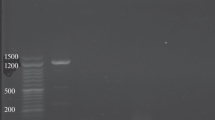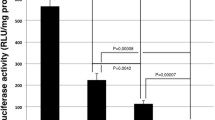Abstract
Foreign DNA fragments from genetically modified defatted soybean meal (GM SEM) in rainbow trout was traced by nested polymerase chain reaction (PCR) and located by in situ hybridization. Either a GM or non-GM SBM formulated diet (42% protein) was fed to fish (average weight 50.5 g) for 2 weeks. The degradation results showed that the cauliflower mosaic virus 35S promoter (220 bp) fragment was detected in the contents of digestive system only in fish fed the GM SBM diet, and it was not detected on the third day after changing the diet to the non-GM SBM diet. For the possible transferal results, the promoter fragment was detected in the leukocyte, head kidney and muscle only of fish fed the GM SBM diet; it was not detected on the fifth day after changing the diet to the non-GM SBM diet. These results suggest that a foreign DNA fragment was not completely degraded and might be taken up into organs through the gastrointestinal tract. However, foreign DNA was not detected after the withdrawal period. Thus, the data show that uptake of DNA from GM SBM might not remain in the tissues of fish fed GM SBM diet.
Similar content being viewed by others
References
Dill GM. Glyphosate-resistant crops: history, status and future. Pest. Manag. Sci. 2005; 61: 219–224.
Cowx IG. Cultured Aquatic Species Information Programme — Oncorhynchus mykiss. [Cited 22 June 2006] Available from URL: http://www.fao.org/fishery/culturedspecies/Oncorhynchus_mykiss
Hammond B, Vicini JL, Hartnell GF, Naylor MW, Knight CD, Robinson EH, Fuchs RL, Padgette SR. The feeding value of soybeans fed to rats, chickens, catfish and dairy cattle is not altered by genetic incorporation of glyphosate tolerance. J. Nutr. 1996; 126: 717–727.
Padgette SR, Taylor NB, Nida DL, Bailey MR, Macdonald J, Holden LR, Fuchs RL. The composition of Glyphosatetolerant soybean seeds is equivalent to that of conventional soybeans. J. Nutr. 1996; 126: 702–716.
Padgette SR, Kolacz KH, Delannay X, Re DB, LaVellee BJ, Tinius CN, Rhodes WK, Otero YI, Barry GF, Eichholtz DA, Peschke VM, Nida DL, Taylor NB, Kishore GM. Development, identification and characterization of glyphosatetolerant soybean line. Crop Sci. 1995; 35: 1451–1461.
Cromwell G, Lindemann MD, Randolph JH, Parker GR, Coffey RD, Laurent KM, Armstrong CL, Mikel WB, Stanisiewski EP, Hartnell GF. Soybean meal from Roundup Ready or conventional soybeans in diets for growingfinishing swine. J. Anim. Sci. 2002; 80: 708–715.
Sanden M, Bruce IJ, Rahman MA, Hemre G. The fate of transgenic sequences present in genetically modified plant products in fish feed, investigating the survival of GM soybean DNA fragments during feeding trials in Atlantic salmon, Salmo salar L. Aquaculture 2004; 237: 391–405.
Palka-Santini M, Schwarz-Harzke BH, Ösel M, Renz D, Auerochs S, Brondke H, Doerfler W. The gastrointestinal tract as the portal of entry for foreign macromolecules: fate of DNA and proteins. Mol. Genet. Genomics 2003; 270: 201–215.
Schubbert R, Lettmann C, Doerfler W. Ingested foreign (PhageM13) survives transiently in the gastrointestinal tract and enters the bloodstream of mice. Mol. Gen. Gener. 1994; 242: 495–504.
Nielsen C, Berdal KG, Bakke-McKellep AM, Holst-Jensen A. Dietary DNA in blood and organs of Atlantic salmon (Salmo salar L.). Eur. Food Res. Technol. 2005; 221: 1–8.
Klotz A, Mayer J, Einspanier R. Degradation and possible carry over of feed DNA monitored in pigs and poultry. Eur. Food Res. Technol. 2002; 214: 271–275.
Reuter T, Aulrich K. Investigations on genetically modified maize (Bt-maize) in pig nutrition: fate of feed-ingested foreign DNA in pig bodies. Eur. Food Res. Technol. 2003; 216: 185–192.
Einspanier R, Klotz A, Kraft J, Aulrich K, Poser R, Schwagele F, Jahreis G, Flachowsky G. The fate of forage plant DNA in farm animals: a collaborative case-study investigating cattle and chicken fed recombinant plant material. Eur. Food Res. Technol. 2001; 212: 129–134.
Rossi F, Morlacchini M, Fusconi G, Pietri A, Mazza R, Piva G. Effect of Bt corn on broiler growth performance and fate of feed-derived DNA in the digestive tract. Poult. Sci. 2005; 84: 1022–1030.
Phipps RH, Deaville ER, Maddison BC. Detection of transgenic and endogenous plant DNA in rumen fluid, duodenal digesta, milk. blood and feces of lactating dairy cows. J. Dairy Sci. 2003; 86: 4070–4078.
Aeschbacher K, Messikommer R, Meile L, Wenk C. Bt176 corn in poultry nutrition: physiological characteristic and fate of recombinant plant DNA in chicken. Poult. Sci. 2005; 84: 385–394.
Schubbert R, Renz D, Schmitz B, Doerfler W. Foreign (M13) DNA ingested by mice reaches peripheral leukocytes spleen and liver via the intestinal wall mucosa and covalently linked to mouse DNA. Proc. Natl. Acad. Sci. USA 1997; 94: 961–966.
Schubbert R, Hohlweg U, Renz D, Doerfler W. On the fate of orallyingested foreign DNA in mice: chromosomal association and placental transmission to the fetus. Mol. Gen. Genet. 1998; 259: 569–579.
Chainark P, Satoh S, Hino T, Viswanath K, Hirono I, Aoki T. Availability of genetically modified soybean meal in rainbow trout (Oncorhynchus mykiss) diets. Fish. Sci. 2006; 72: 1072–1078.
Ogino C, Takeuchi L, Takeda H, Watanabe T. Availability of dietary phosphorus in carp and rainbow trout. Nippon Suisan Gakkaishi 1979; 45: 1527–1532.
Murray MG, Thompson WF. Rapid isolation of high molecular weight plant DNA. Nucleic Acids Res. 1980; 8: 4321–4325.
Sambrook J, Russell DW. Molecular Cloning: a Laboratory Manual, Vol. 1. Cold Spring Harbor Laboratory Press, New York, NY. 2001.
Miller SA, Dykes DD, Polesky HF. A simple salting out procedure for extracting DNA from human nucleated cells. Nucleic Acids Res. 1988; 16: 1215.
Nicole MV, Jeffrey DK, Lindsey AN, Mark AS. Isolation, characterization, and distribution of two cDNAs encoding for growth hormone receptor in rainbow trout (Oncorhynchus mykiss). Comp. Biochem. Physiol. B 2005; 140: 615–628.
Matsuoka T, Kawashima Y, Akiyama H, Miura H, Goda Y, Sebata T, Isshiki K, Toyoda M, Hino A. A detection method for recombinant DNA from genetically modified soybeans and processed foods containing them. Shokuhin Eiseigaku Zasshi (J. Food Hyg. Soc. Jpn.) 1999; 40: 149–157 (in Japanese).
Chiter A, Forbes JM, Blair GE. DNA stability in plant tissues: implications for the possible transfer of genes from genetically modified food. FEBS Lett. 2000; 481: 164–168.
Forbes JM, Blair GE, Chiter A, Perks S. Effect of feed processing condition on DNA fragmentation. Scientific Report No. 376 to the Ministry of Agriculture, Fisheries and Food, United Kingdom, 1998.
Hohlweg U, Doerfler W. On the fate of plant or other foreign genes upon the uptake in food or after intramuscular injection in mice. Mol. Genet. Genomics 2001; 265: 225–233.
Chowdhury EH, Mikami O, Nakajima Y, Hino A, Kuribara H, Suga K. Hanazumi M, Yomemochi C. Detection of genetically modified maize DNA fragments in the intestinal contents of pigs fed StarLink CBH351. Vet. Hum. Toxicol. 2003; 45: 95–96.
Chowdhury EH, Mikami O, Murata H, Sultana P, Shimada N, Yoshioka M, Guruge KS, Yamamoto S, Miyazaki S, Yamanaka N, Nakajima Y. Fate of maize intrinsic and recombinant genes in calves fed genetically modified maize Btll. J. Food. Prot. 2004; 67: 365–370.
Chambers PA, Duggan PS, Heritage J, Forbes JM. The fate of antibiotic resistance marker genes in transgenic plant feed material fed to chickens. J. Antimicrob. Chemother. 2002; 49: 161–168.
Press CM, Evensen Ø. The morphology of the immune system in teleost fishes. Fish Shellfish Immunol. 1999; 9: 309–318.
Beever DE, Kemp CF. Safety issues associated with the DNA in animal feed derived from genetically modified crops. A review of scientific and regulatory procedures. Nutr. Abstr. Rev. Series B 2000; 70: 175–182.
Sato Y, Roman M, Tighe H, Lee D, Corr M, Nguyen MD, Silverman GJ, Lotz M, Carson DA, Raz E. Immunostimulatory DNA sequences necessary for effective intradermal gene immunization. Science 1996; 273: 352–354.
Nielsen C, Berdal KG, Holst-Jensen A. Persistence and distribution of intravenously injected DNA in blood and organs of Atlantic salmon (Salmo salar L.). Eur. Food Res. Technol. 2006; 222: 258–265.
Mazza R, Soave M, Morlacchini M, Piva G, Marocco A. Assessing the transfer of genetically modified DNA from feed to animal tissues. Transgenic Res. 2005; 14: 775–784.
Bernstein JJ, Streicher E. The blood-brain barrier of fish. Exp. Neurol. 1965; 11: 464–473.
Froystad MK, Rode M, Berg T, Gjoen T. A role for scavenger receptors in phagocytosis of protein-coated particles in rainbow trout head kidney macrophages. Dev. Comp. Immunol. 1998; 22: 533–549.
Tony M, Butschke A, Broll H, Grohmann L, Zagon J, Halle I, Danicke S, Schauzu M, Hafez HM, Flachowsky G. Safety assessment of Bt 176 maize in broiler nutrition: degradation of maize-DNA and its metabolic fate. Arch. Tierernahr. 2003; 57: 235–252.
Author information
Authors and Affiliations
Corresponding author
Rights and permissions
About this article
Cite this article
Chainark, P., Satoh, S., Hirono, I. et al. Availability of genetically modified feed ingredient: investigations of ingested foreign DNA in rainbow trout Oncorhynchus mykiss . Fish Sci 74, 380–390 (2008). https://doi.org/10.1111/j.1444-2906.2008.01535.x
Received:
Accepted:
Issue Date:
DOI: https://doi.org/10.1111/j.1444-2906.2008.01535.x




